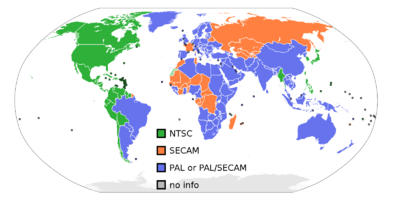NTSC
Within the video game community, NTSC is a term used to refer to the region of North America and small parts of South America and Asia. The term comes from the analog television encoding system National Television System Committee, the primary method of encoding analog TV for North America, South America, and Japan. This is opposed to PAL, which is the standard used in Europe, Australia, Africa, and most of South America and Asia.
However, the Japanese NTSC encoding (referred to colloquially as NTSC-J) is slightly different than the international NTSC coding, so there are generally minor differences between the two. Due to this, NTSC is most commonly used as shorthand for all NTSC based regions, but NTSC-U is used for "the North American version of a game", while NTSC-J is used for "the Japanese version of a game" (although NTSC-J is technically also used in some other east Asian countries, such as South Korea and Taiwan). Historically, North America is usually the second region for games made in Japan to be released; compared to the many European languages that require their own translations, fewer translations are necessary for the greater NTSC market (English at least, with French, Spanish, and German being the most common secondary translations). As a result, NTSC-U releases are often the second version of Nintendo games, with potential major bugs fixed and possibly minor changes added.
In the context of competitive Super Smash Bros., the region which is standard for competitive play depends on the game, and difficulties can arise because of this. From Brawl onwards, whatever region is played depends on the country that is running the tournament, as all regions are the same gameplay-wise. For Smash 64, the NTSC-J version is played in Japan, while in North America and even PAL regions, the NTSC-U version is typically played. Both versions have numerous differences to mechanics and character balance. The PAL versions also have changes to character balance, and while they were typically played in Europe and Australia originally, those regions have adopted the NTSC-U version in more recent years. For Melee, the NTSC versions are used globally, with the NTSC-U and J versions being identical gameplay-wise. Europe and Australia did use the PAL version for quite a long time, as the PAL version had numerous balance changes, but in more recent years, those regions have adopted the NTSC version.
Summary of NTSC releases of the Super Smash Bros. series
Super Smash Bros.
The original Super Smash Bros.'s NTSC-U release contains a lot of changes from its NTSC-J counterpart. Several changes were made to mechanics and every character. Some characters like Link and Ness, were noticeably nerfed from their Japanese counterparts, while others like Yoshi and Jigglypuff were noticeably buffed. As mentioned earlier, the NTSC-J version is played in Japan but the NTSC-U version is played in other regions.
Super Smash Bros. Melee
Aside from translations, there is effectively no difference at all between the NTSC versions of Melee, with every version even having English and Japanese as language options. North America and Japan received the same revisions between versions 1.0, 1.01, and 1.02, while other NTSC regions (such as South Korea) only received version 1.02, which is the standard in tournaments.
Super Smash Bros. Brawl
In order for cross-region online play to be possible, the only differences between versions of Brawl are purely aesthetic, though they are still encoded differently.
Super Smash Bros. 4 / Super Smash Bros. Ultimate
Neither version of Smash 4, nor Ultimate, use analog connections, and as such, the North American versions of these games only have aesthetic differences from their original Japanese counterparts, similarly to Brawl. As the Nintendo Switch is region free, Ultimate essentially only has one version, with all of its regional differences built into the cartridge.

